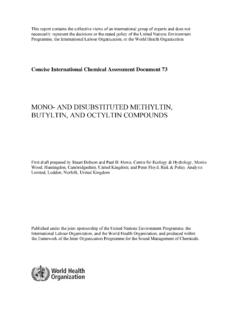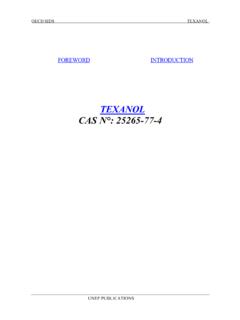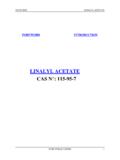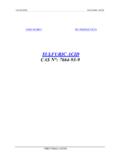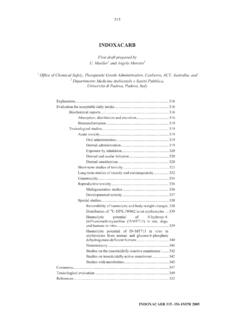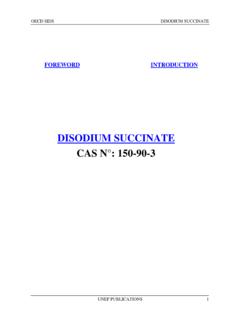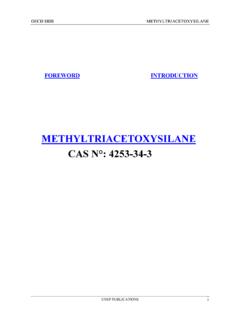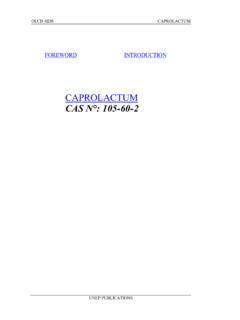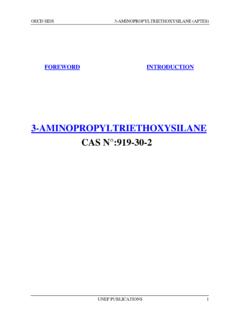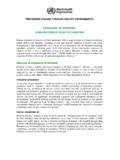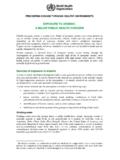Transcription of SKIN SENSITIZATION IN CHEMICAL RISK ASSESSMENT
1 This report contains the collective views of an international group of experts and does not necessarily represent the decisions or the stated policy of the world health organization , the international Labour organization or the United Nations Environment programme . Harmonization Project Document No. 5. SKIN SENSITIZATION IN CHEMICAL RISK ASSESSMENT . This project was conducted within the IPCS project on the Harmonization of Approaches to the ASSESSMENT of Risk from Exposure to Chemicals. Published under the joint sponsorship of the world health organization , the international Labour organization and the United Nations Environment programme , and produced within the framework of the Inter- organization programme for the Sound Management of Chemicals.
2 The international programme on CHEMICAL safety (IPCS), established in 1980, is a joint venture of the United Nations Environment programme (UNEP), the international Labour organization (ILO) and the world health organization (WHO). The overall objectives of the IPCS. are to establish the scientific basis for ASSESSMENT of the risk to human health and the environment from exposure to chemicals, through international peer review processes, as a prerequisite for the promotion of CHEMICAL safety , and to provide technical assistance in strengthening national capacities for the sound management of chemicals.
3 The Inter- organization programme for the Sound Management of Chemicals (IOMC) was established in 1995 by UNEP, ILO, the Food and Agriculture organization of the United Nations, WHO, the United Nations Industrial Development organization , the United Nations Institute for Training and Research and the Organisation for Economic Co-operation and Development (Participating Organizations), following recommendations made by the 1992 UN Conference on Environment and Development to strengthen cooperation and increase coordination in the field of CHEMICAL safety .
4 The purpose of the IOMC is to promote coordination of the policies and activities pursued by the Participating Organizations, jointly or separately, to achieve the sound management of chemicals in relation to human health and the environment. WHO Library Cataloguing-in-Publication Data Skin SENSITIZATION in CHEMICAL risk ASSESSMENT . (IPCS harmonization project document ; no. 5). , Allergic contact. - toxicity. ASSESSMENT . programme on CHEMICAL safety . ISBN 978 92 4 156360 4 (NLM classification: WR 160). world health organization 2008.
5 All rights reserved. Publications of the world health organization can be obtained from WHO. Press, world health organization , 20 Avenue Appia, 1211 Geneva 27, Switzerland (tel.: +41 22 791. 2476; fax: +41 22 791 4857; e-mail: Requests for permission to reproduce or translate WHO publications whether for sale or for non-commercial distribution should be addressed to WHO Press, at the above address (fax: +41 22 791 4806; e-mail: The designations employed and the presentation of the material in this publication do not imply the expression of any opinion whatsoever on the part of the world health organization concerning the legal status of any country, territory, city or area or of its authorities, or concerning the delimitation of its frontiers or boundaries.))
6 Dotted lines on maps represent approximate border lines for which there may not yet be full agreement. The mention of specific companies or of certain manufacturers' products does not imply that they are endorsed or recommended by the world health organization in preference to others of a similar nature that are not mentioned. Errors and omissions excepted, the names of proprietary products are distinguished by initial capital letters. All reasonable precautions have been taken by the world health organization to verify the information contained in this publication.
7 However, the published material is being distributed without warranty of any kind, either express or implied. The responsibility for the interpretation and use of the material lies with the reader. In no event shall the world health organization be liable for damages arising from its use. TABLE OF CONTENTS. FOREWORD ..1. LIST OF CONTRIBUTORS ..3. LIST OF ACRONYMS AND ABBREVIATIONS ..6. SKIN SENSITIZATION IN CHEMICAL RISK ASSESSMENT : REPORT OF A. WHO/IPCS international WORKSHOP FOCUSING ON. DOSE RESPONSE H. Van Loveren, A.
8 Cockshott, T. Gebel, U. Gundert-Remy, De Jong, J. Matheson, H. McGarry, L. Musset, Selgrade, and C. Vickers APPENDIX A: The use of human data when conducting dermal SENSITIZATION quantitative risk assessments for fragrance Api Application of the local lymph node assay (LLNA) for respiratory sensitizers ..29. Arts, De Jong, H. Van Loveren, and Kuper Information derived from SENSITIZATION test methods: test sensitivity, false positives, and false negatives ..32. D. Basketter Skin SENSITIZATION a regulatory overview.
9 36. A. Cockshott Quantification, potency, and risk ASSESSMENT : induction versus Gerberick Uncertainty factors and risk ASSESSMENT for skin sensitizers ..46. P. Griem Hazard identification (human data) ..54. Johansen Clinical experience informing risk C. Lid n iii Harmonization Project Document No. 5. Perspective of the United States Environmental Protection Agency's Office of Pesticide Programs on ASSESSMENT of dermal SENSITIZATION risk using hexavalent chromium as a case-study ..63. McMahon and J. Chen New approaches for skin SENSITIZATION hazard identification: (Q)SARs/expert G.
10 Patlewicz New approaches for hazard identification: the development of in vitro methods for predicting contact SENSITIZATION Ryan SENSITIZATION potency of M. Takeyoshi New approaches to hazard identification: non-radioactive alternatives ..80. Vohr iv Skin SENSITIZATION in CHEMICAL Risk ASSESSMENT FOREWORD. Harmonization Project Documents are a family of publications by the world health organization (WHO) under the umbrella of the international programme on CHEMICAL safety (IPCS) (WHO/ILO/UNEP). Harmonization Project Documents complement the Environmen- tal health Criteria (EHC) methodology (yellow cover) series of documents as authoritative documents on methods for the risk ASSESSMENT of chemicals.
